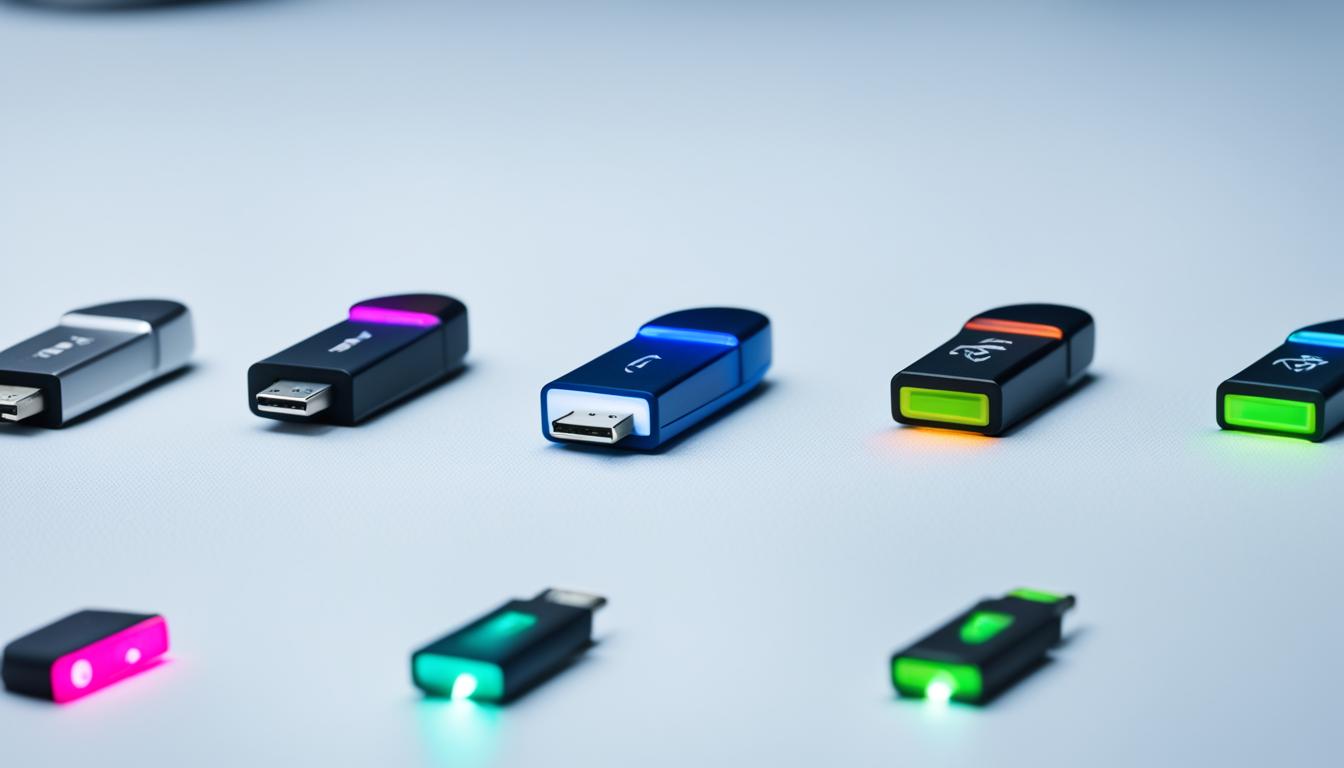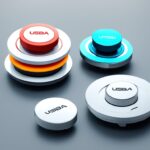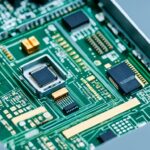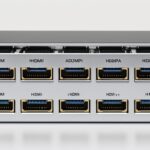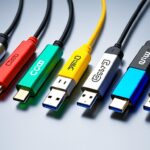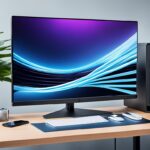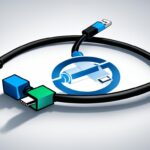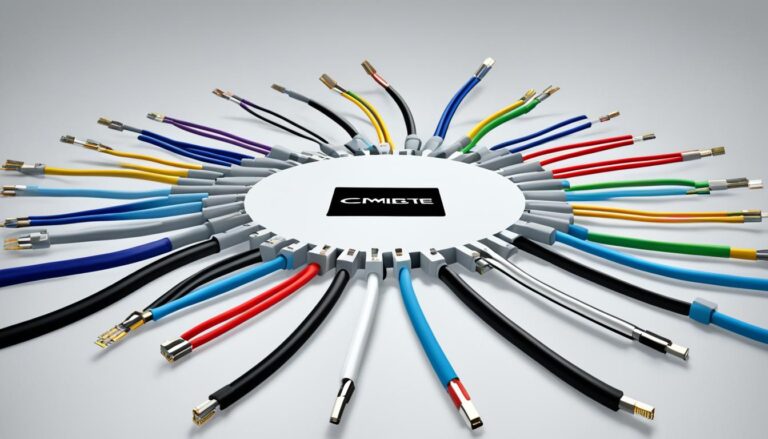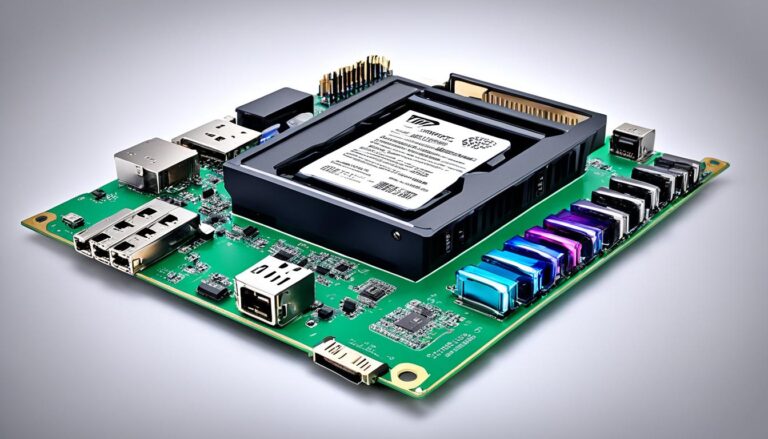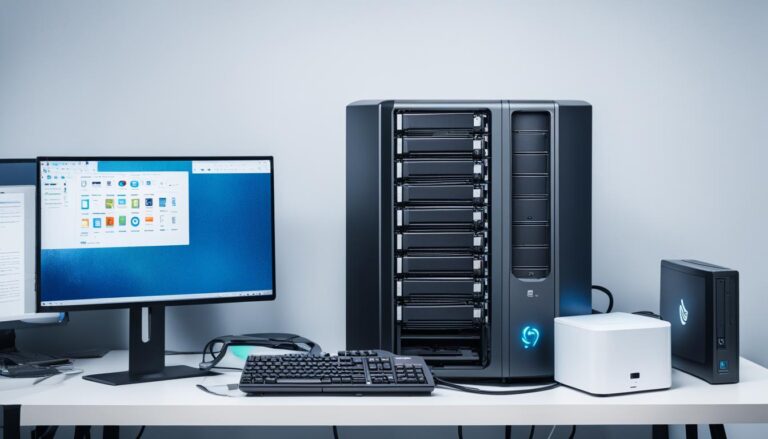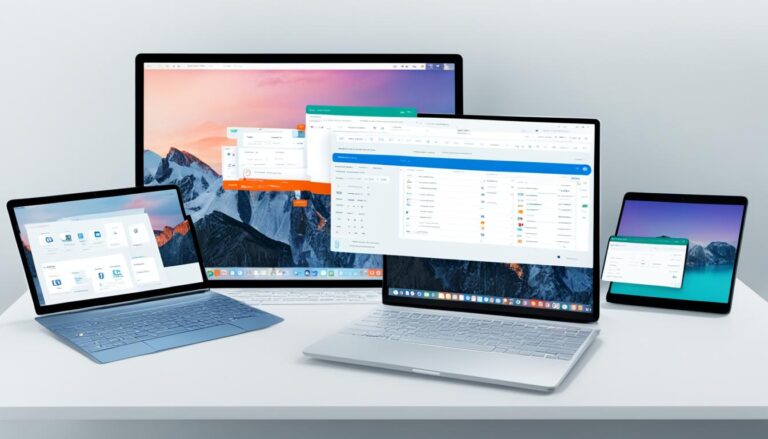USB buttons are key to many gadgets, making them easy and fun to use. They are in computers, game gear, and more. These buttons have lots of jobs and are super handy.
Turning devices on and off is simple with USB buttons. You don’t need tricky commands. Just press the button, and you’re all set. It saves time and makes things straightforward.
These buttons also let you plug in things like keyboards and hard drives. This way, you can add more features to your device easily. It’s great for upgrading your gadget’s abilities.
What’s more, you can set USB buttons to do certain tasks. You could set one to start a slideshow or change songs. This lets you do your work smoother and quicker.
USB buttons work with the USB system and act like keyboard keys. You can set them up to send different signals. So, they work with all sorts of computers and systems. Whether it’s a Windows PC, a Mac, or Linux, USB buttons fit right in.
In summary, USB buttons are super useful in tech devices. They make it easy to turn on/off gadgets, connect extra gear, and do special tasks. With the ability to program them and their wide compatibility, USB buttons are a great feature to have.
Buttons and Ports on a Computer
Computers have many buttons and ports, each with a unique role, making them more useful and connected. Let’s dive into what buttons and ports are found on most computers.
Front Buttons and Ports
The front part of a computer has buttons and ports for different uses. The button for the optical disc drive lets you put in or take out discs easily. This is handy for installing software or playing media.
Right by it, there’s a power button. Push it to turn your computer on or off easily.
The front also has ports for plugging in headphones or mics. These are great for listening to music, recording, or talking online.
Plus, there are USB ports on the front. They let you connect things like USB drives, keyboards, and cameras quickly, without having to reach the back.
Back Connection Ports
The back of a computer has many ports for connecting it to other devices.
There’s a power port for connecting to an electrical outlet. This gives the computer the power it needs to work.
You’ll also find audio ports at the back. These are for connecting speakers, headphones, and mics for good sound quality.
Ethernet ports at the back let you connect to local networks or the internet. They’re essential for going online.
Like the front, the back has USB ports too. They provide more spots for hooking up USB gadgets and enhance the computer’s abilities.
A monitor port is also at the back. It’s used for connecting your computer to a monitor or projector for visuals.
Some computers have serial and PS/2 ports as well. They’re for specific devices that need these types of connections.
Expansion Slots
Computers also have expansion slots for adding extra parts or improving their functions.
With these slots, you can add things like graphics or sound cards. They let you customise your computer’s performance as you like.
In summary, a computer’s buttons and ports make it easy and flexible for users to connect a variety of devices and accessories. This enhances the overall computing experience.
| Button/Port | Location | Functionality |
|---|---|---|
| Optical Disc Drive Button | Front Panel | Ejects or inserts discs in the optical drive |
| Power Button | Front Panel | Turns the computer on or off |
| Audio In/Output Ports | Front Panel | Connects headphones, microphones, or speakers for audio input/output |
| USB Ports | Front Panel | Connects USB devices such as keyboards, mice, or flash drives |
| Power Port | Back Panel | Connects the computer to a power source |
| Audio Ports | Back Panel | Connects audio devices for sound input/output |
| Ethernet Port | Back Panel | Connects the computer to a network for internet access |
| USB Ports | Back Panel | Additional USB connections for device connectivity |
| Monitor Port | Back Panel | Connects a display device for visual output |
| Serial Port | Back Panel | Connects specific peripherals requiring serial communication |
| PS/2 Port | Back Panel | Connects specific peripherals requiring PS/2 connection |
| Expansion Slots | Internal | Allows for adding extra components or expansion cards |
Key: Optical Disc Drive Button, Power Button, Audio In/Output Ports, USB Ports, Power Port, Audio Ports, Ethernet Port, Monitor Port, Serial Port, PS/2 Port, Expansion Slots
USB Pushbutton Functionality
A USB pushbutton is a handy device that connects via a USB cable. You can use it like a keyboard button to do specific tasks on your computer. It’s seen by your computer as a keyboard with just one button. Also, you don’t need extra software to get it working on different systems.
This button lights up with an LED. It has a special circuit to prevent mistakes and a filter to protect it from electrical shocks. This makes it reliable.
When you plug a USB pushbutton into your computer, it works smoothly. It acts like a keyboard button but can do specific tasks you’ve set. This makes controlling your devices easy.
No matter if you use Windows, macOS, Linux, or Android, USB pushbuttons work well. They don’t need extra software, so using them is straightforward.
The button’s LED light helps you see it clearly. You can even change the light to fit what you like or need. This makes it both practical and personal.
USB pushbuttons have a special circuit to stop accidental presses. This means the button only reacts to real presses, making it more precise.
They also have protection against electric shocks. This keeps the button and your device safe, making them last longer.
In summary, USB pushbuttons are great for managing your devices. They’re easy to use on any system, light up for visibility, and come with features that make them reliable. These features ensure a great experience and better control.
USB Pushbutton Features
The USB pushbutton is a big, light-up button you can use indoors. It has a 1m long cable but works with cables up to 5m long. It’s easy to mount thanks to a removable interface at the bottom. This button acts like a single key on a keyboard, and you can set it to press a specific key.
It’s a tough cookie, lasting over 106 operations. With 8 to 10 N of pressure needed, it’s comfy and quick to react.
This button gets its power from the USB connection, so no need for extra power sources. It fits right into your USB setup, making it easy to start using.
It has a special 20ms rule to stop it from accidental presses. This makes sure it only responds when you actually press it. It’s set up to work well for many different jobs.
It’s handy for loads of things like factory controls, info points, or games. The USB pushbutton is ready for whatever you need.
“The USB pushbutton’s ergonomic design and customizable functionality make it a valuable addition to any device or system.”
USB Pushbutton Specifications
The USB pushbutton is a versatile device with specific dimensions and features that enhance its functionality. Here are the specifications for the USB pushbutton:
| Specifications | Details |
|---|---|
| Base Diameter | 98mm |
| Dome Diameter | 80mm |
| Base Color | Black |
| Dome Color | Red |
| Mechanical Lifetime | Over 106 operations |
| Actuation Force | 8 to 10 N |
| Connector | Mini-B USB |
| USB Interface/Profile | USB “HID” with a configurable key code |
| Power Source | USB connection |
| Nominal Current | 15mA (non-illuminated), 35mA (illuminated) |
| Debounce Criterion | 20ms stable period |
| Switch Latency | 50ms maximum, 35ms average |
The USB pushbutton is designed to meet specific requirements and deliver exceptional performance. It has a sturdy build, ensuring a long mechanical lifetime of over 106 operations. The actuation force of 8 to 10 N provides tactile feedback, offering a satisfactory user experience.
The button comes with a Mini-B USB connector for easy connectivity. It also features a USB “HID” interface/profile. This offers versatility through configurable key codes.
The button is powered through the USB connection, using 15mA when not illuminated and 35mA when illuminated. This makes it energy-efficient. It also has a debounce criterion of 20ms to prevent false triggers, ensuring reliable operation. The switch’s response is quick, with a maximum latency of 50ms and an average of 35ms.
The USB pushbutton’s specifications make it a reliable and adaptable device for various applications. Its dimensions, colors, and performance capabilities contribute to its effectiveness and user satisfaction.
USB Pushbutton Application Notes
The USB pushbutton is very versatile and useful. It’s good for lots of things like being a quiz buzzer or part of game controls. It can also work with digital cameras. This button is great because it can make playing games better, help with recording sounds, or connect phones to computers. You can change its settings with a program called KeyConfigurator. This makes the button do exactly what you need.
Another great thing is how well it works with many computer systems. It doesn’t matter if you use Windows, macOS, Linux, or Android. The USB pushbutton will work smoothly with them. This means more people can use it without any trouble.
There are also extra bits and programs you can get for the USB pushbutton. These let you change how the button lights up or how it switches. You can make it suit your needs perfectly. Whether you want to adjust its light or how it reacts, these add-ons make it flexible.
| Application | Description |
|---|---|
| Quiz Buzzer | Used in quizzes and game shows, the USB pushbutton serves as a buzzer for participants to signal their readiness to answer a question. |
| Game Controllers | The USB pushbutton is utilized as a component of game controllers, enhancing the gaming experience by providing a responsive and programmable input. |
| Digital Cameras | With the USB pushbutton, photographers can remotely trigger the shutter of their digital cameras, allowing them to capture that perfect shot without touching the camera itself. |
| Computer Games | By connecting the USB pushbutton to a computer, users can control various aspects of computer games, providing a more immersive and interactive gameplay experience. |
| Sound Recording | The USB pushbutton can be paired with a microphone to conveniently record sound without the need for complex setups or additional equipment. |
| Device Connectivity | Mobile phones and other devices can be easily connected to a computer using the USB pushbutton, simplifying data transfer and device management. |
USB Pushbutton Hardware Overview
The USB pushbutton belongs to the PBT product series, known for its tough, vandal-proof design. It’s built to last, enduring over a million presses. Whether using a hand or foot, it’s easy and flexible to operate.
This device imitates a Human Interface Device (HID) keyboard and mouse with one button. It can also mimic up to 6 keyboard keys at once. This gives users more control, making it perfect for different industries and their needs.
It supports key strokes in a sequence and typing full strings when pressed, held, or released. This feature helps users automate tasks, boosting their work speed and effectiveness.
The built-in flash memory stores your settings, avoiding the need for repeated setups. Plus, an internal USB serial interface makes programming simple. This design saves both time and effort.
It works with Windows, macOS, Linux, and Android. This broad compatibility makes it easy to use across various devices and applications.
Technical Specifications
| Dimensions | Base Color | Dome Color | Mechanical Lifetime | Actuation Force | Interface | Power Supply |
|---|---|---|---|---|---|---|
| Base diameter 98mm, dome diameter 80mm | Black | Red | Over 10^6 operations | 8-10 N | USB “HID” (Human Interface Device) with configurable key code | USB connection |
This USB pushbutton meets tough industrial standards and performs reliably. Its impressive hardware and OS compatibility make it ideal for industrial spaces, gaming, or automation systems. It enhances user interaction and ensures smooth operation.
Conclusion
USB buttons are key to making our gadgets work well. They help turn devices on/off, connect things, and run special commands. You can set these buttons to do what you want, making them fit your needs. They work with many devices and systems, making life easier.
USB buttons are found in computers and game controllers. They make using devices simpler. By setting up shortcuts, they help us do tasks quicker. This boosts our work speed and efficiency.
USB buttons let us customise how we interact with our tech. You can program them for various tasks. This is great for gamers, multimedia enthusiasts, and professionals. They are adaptable for many uses.
FAQ
What is the functionality of USB buttons on devices?
USB buttons have many roles. They turn devices on or off and hook up extras. They help with sound in/out too. Some are programmable for certain tasks or commands.
Where can USB buttons be found on a computer?
USB buttons are on desktops and more. You’ll find them on the computer’s front and back. They sit near power buttons, sound ports, and USB links.
How does a USB pushbutton function?
A USB pushbutton, much like a palm switch, joins your PC via USB. It sends keyboard commands. The device spots it as a keyboard with just one button.
What are the features of a USB pushbutton?
The pushbutton lights up thanks to an LED. It’s made to stop accidental presses. Plus, it’s shielded against electrical surges. No extra drivers are needed, and it works with many systems.
What are the specifications of a USB pushbutton?
This pushbutton is quite sizable. It connects with a Mini-B USB. It’s known as a USB “HID” and you can set its key code. It needs a certain force to press and lasts very long.
What are some application notes for the USB pushbutton?
The pushbutton is quite versatile. Use it in buzzers, game pads, or digital cameras. It’s great for gaming, recording, or linking phones to computers.
What is the hardware overview of the USB pushbutton?
It’s a tough PBT series item. It handles millions of presses, by hand or foot. It acts as a keyboard/mouse for up to 6 keys at once.
How do USB buttons enhance the functionality and user experience of devices?
USB buttons make devices better and easier to use. They add lots of functions. For example, turning devices on/off, connecting gear, and setting up specific commands.
